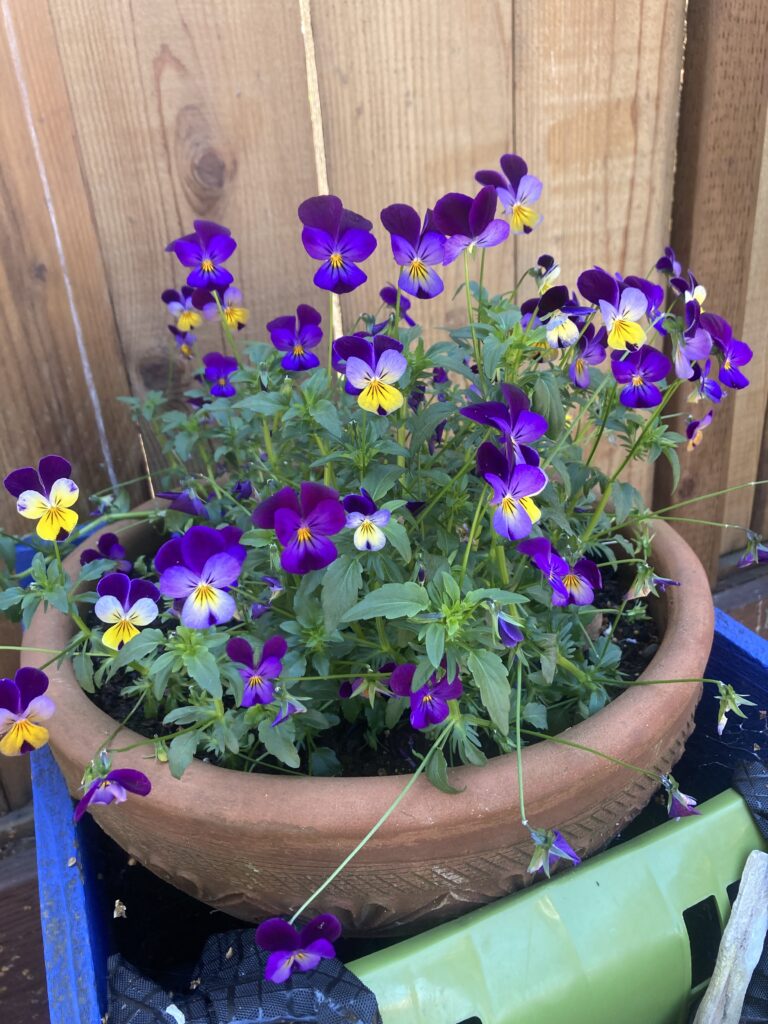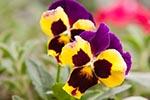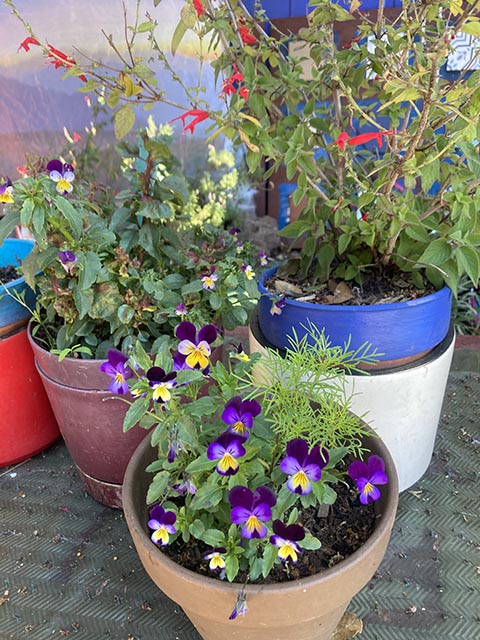People, Pets & Other Animals Can Eat Pansies
If you are wondering if pansies are safe for pets like cats or if they are poisonous to pets like dogs, we are happy to announce that pansies (a floral relative to violas) and its many varieties are all non toxic to pets. We have giant and dwarf varieties in Lovie’s Pet Safe Garden in Northern California and enjoy their colorful purple and yellow bloom year-round- yes, year-round! The dwarf variety we have in our front and backyards are called “Johnny Jump Ups” and we love them. They are pretty resilient. They do spread a bit or jump up in areas where I hadn’t planted them but I actually enjoy their surprise cameo appearance in unexpected spots. I’m glad that pansies are okay around cats and dogs because I am more than okay having them around to beautify our shared outdoor space.

So you know, we check the flowers we feature on our site with the ASPCA and do extensive internet research for both the common and scientific name just to be super pet safe. If we cannot find direct reference, we check up to genus and so on until we can confirm whether a plant is toxic or non toxic to both cats and dogs. If we are not sure, or get contradictory information, we do not include it. Many of the plants featured we have grown successfully in our own pet safe garden in Northern California. You can see many of garden stars in photos from Lovie’s Pet Safe Garden.

Physical Attributes
Pansies have flat, round flowers with overlapping petals in a wide range of colors including purple, blue, yellow, white, red, orange, and bi-colors. The petals often have distinctive dark blotches or “faces”. Pansies grow low to the ground in a mounding shape, reaching 6-9 inches tall with a similar spread. The leaves are oval and slightly wrinkled.[1][2][3]
General Care Tips
Plant pansies in well-draining soil and full sun to partial shade. Water regularly to keep soil moist but not saturated. Deadhead spent flowers to prolong blooming. Apply a balanced liquid fertilizer every 2-4 weeks. Pansies prefer cooler temperatures and may go dormant in summer heat. Mulch plants to keep roots cool.[1][2][3][4]
Fun Facts
- Pansies are derived from violas and get their name from the French “pensée” meaning “thought” or “ponder”.[2]
- They are edible and can be used to decorate salads, desserts, or as a garnish. They have a slightly perfumed flavor.[1][3]
- Pansies were used in the late 19th century to represent free thought in the language of flowers.[2]
- They are considered a cool weather annual in most climates but can be grown as a perennial in very cold regions.[1][4]
- Pansies are a favorite of children due to their “faces” and wide array of bright colors.[3]

| Consideration | Details |
|---|---|
| Container Friendly | Yes, pansies do well in containers.[1][2][3][4][5] |
| Indoor/Outdoor | Outdoor is best, but can be grown indoors with sufficient sunlight.[1][4] |
| Sun/Shade | Prefer full sun to partial shade. At least 6 hours of sun.[1][3][4][5] |
| Perennial/Annual | Grown as a cool-season annual in most climates, but can be short-lived perennial in mild areas.[1][4] |
| Flowering | Bloom in spring, fall, and winter with overlapping petals in many colors.[1][2][3][4][5] |
| Drought Tolerant | No, pansies require consistent moisture.[3][5] |
| Pollinator Magnet | No, not known to be a significant pollinator attractant. |
| Beginner Friendly | Yes, pansies are relatively easy for beginners to grow.[1][3][4] |
| Good Ground Cover | No, pansies grow in low mounds 6-9 inches tall.[1][4] |
| Good Privacy Screen | No, not tall enough for a privacy screen. |
| Invasive/Spreader | No, pansies form clumps but do not spread invasively.[1][2][3][4][5] |
| Hearty/Delicate | Hearty for cool weather, but delicate in heat.[1][4] |
| Rodent Repellent | Unknown, but likely not a rodent repellent. |
| Deer Resistant | No, deer often browse on pansies.[1] |
| Ideal States | Cool, humid regions like the Pacific Northwest.[1][4] |
Citations:
[1] https://www.thespruce.com/pansies-growing-a-cool-weather-favorite-1402913
[2] https://extension.uga.edu/publications/detail.html?number=B1359&title=success-with-pansies-in-the-winter-landscape-a-guide-for-landscape-professionals
[3] https://fgsdurham.com/blog/pansy-care-tips/
[4] https://www.almanac.com/plant/pansies
[5] https://greenkin.in/blogs/plant-talk/how-to-grow-and-care-for-pansy-flower-plant
Citations:
[1] http://www.gardening.cornell.edu/homegardening/scene9108.html
[2] https://www.monrovia.com/be-inspired/lavender-plant-care-guide.html
[3] https://extension.okstate.edu/fact-sheets/basic-plant-care-understanding-your-plants-needs.html
[4] https://www.gardenia.net/guide/how-to-plant-care-grow-gorgeous-lavender
[5] https://www.southernliving.com/orchid-tree-7486707





